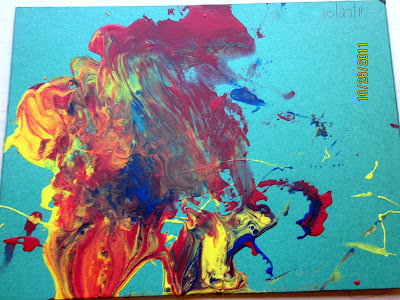 |
| Making rain drops. |
 |
| Feeling the glue. |
I've purchased different versions of glitter glue and colored glue over the years but the children have struggles with them. Either the glue comes out so fast that it's gone in an instant or the bottles are designed in a way that the toddlers cannot squeeze hard enough (and they will try!) to get the glue to come out. I've tried to make different kinds of glitter or colored glue over the years with varying levels of success. So this time, we made our own colored glue by mixing powder paint with white glue and then putting it in some squeeze bottles that we had been using for paint. I also found some airtight containers to save the extra glue in so we don't have to make it every day. We can go through a lot of glue in a day and running out was one of the issues we were having.
 |
| Getting started |
A parent had recently gotten a huge pile of mat board donated from a framer that was closing up shop, which was perfect for the glue pictures. Because we have so much, this project has been happening every day. It wasn't until the middle of the week that I came up with the idea of using the old paint bottles for the glue and that is when the exploration really took off. By Thursday, their interest was still strong in the glue so the the new glue bottles came out. There were only four bottles and it just happened that four children wanted to play. They each went to the stack of mat board, chose their board and brought it to the table. Each child was given a bottle of glue and they got to work. They were excited to be using the new bottles and seeing the vibrant colors of the glue.
Some of them started out by continuing their exploration from earlier in the week. We had more children making raindrops by holding the bottles up high and squeezing slowly. They would watch the drops fall onto their board and try to make the drops change size or fall into a particular spot. There were some who squeezed glue into their hands and rubbed it in as if they were washing them. Toddlers are still very sensory oriented so I let them explore without interruption. If I stop them from trying things like this, they will still find a way and usually a less desirable way to explore.
Then something really amazing happened. I had turned my back to write something down and when I was finished and turned back to the table, S. was telling me that he and D. had traded glue. Apparently they wanted to try another color so they figured out a way to make that happen. As I watched and they continued to explore, this spontaneous trading of glue bottles happened again and again. There were occasional disagreements about how long they should wait for their next turn or which color they wanted but, they worked it all out themselves. No temper tantrums, no crying and no need for adult intervention. These two-year-olds talked through each situation, listening to their peers and negotiating to the best of their abilities.
 |
| They started trading glue bottles so they could have more colors on their boards. |
The irony is that my co-teacher and I had just recently been discussing how much they had been relying on us for help because the staff, the student staff and the two of us, had been stepping in too often and rescuing them when they probably could have solved their problems on their own or with less help. This is a pattern we have noticed over the last two years. Each semester, we get several new children so they need a little more support as they get used to the routines and tasks associated with full-day child care. The 'old' children that have been with us need help adjusting to the new children, sharing their primary caregiver's time with the new children and figuring out what their place or role is now. But there comes a time when we need to let them try more on their own. And we had passed that point a couple of several weeks ago.
 | ||
| Some glue spilled onto the table so he decided to clean it up, which lead to cleaning up his picture as well. |
 |
| The finished, dry project. |
So over that last few weeks we have been stepping in less often, usually only for repeated problems or when things looks like they may get physical. We are also watching more, and coaching the new staff to watch, for each child's non-verbal cues that they are reaching that peak of frustration and really do need some help. Watching them work out the turn-taking and social problem-solving shows me that we have been doing the right thing. As an added benefit, we ended up with some amazing pictures. The pictures are another sensory activity as they love to run their hands over them to feel the glue patterns and textures. And they are learning about the properties of glue and what happens when it is left out to dry.
 |
Toddlers are capable of doing much more on their own than we sometimes give them credit for. So when I look at wonderful pictures they created, I will be reminded of all the things these toddlers are capable of doing on their own and what great problem solving skills they have.
































